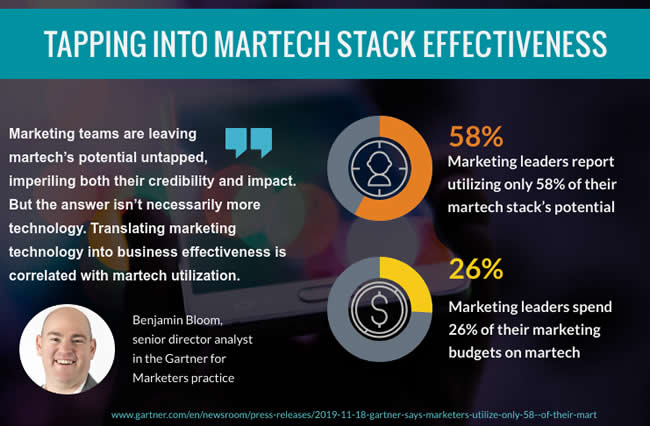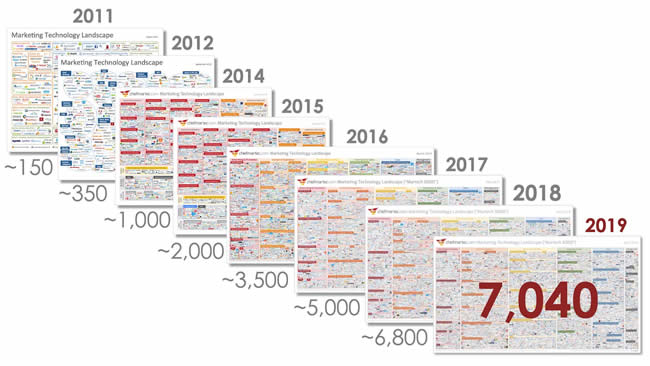While marketers are expected to increase their martech investments according to most forecasts (some see temporary slower growth ahead for 2020, though not necessarily structural) existing marketing technology stacks are still being underutilized. How can marketers increase martech stack effectiveness?
29% of marketing leaders indicate that training and upskilling existing martech talent is a major impediment to their martech stack effectiveness
The underutilization of digital marketing technologies isn’t new; it’s a phenomenon that exists since long before anyone used the term martech, social media popped up and the first marketing automation platforms hit the market.
Yet, with ongoing investments in marketing technologies and the seemingly never-ending expansion of the martech space and its various categories and players (ask Scott Brinker, behind the popular marketing technology landscape infographic and solution spreadsheet), the issue is perhaps more noteworthy as marketing executives struggle to tap into martech stack effectiveness in their quest to enable a better customer experience across touchpoints, increase marketing ROI and maximize lifetime value in these days of big data and digital transformation.
Per Gartner’s CMO Spend Survey, 2019-2020, marketing leaders spend 26 percent of their marketing budgets on martech. Yet, the latest Gartner Marketing Technology Survey 2019 findings show that marketing leaders report utilizing only 58% of their martech stack’s potential. Gartner points out two factors standing in the way of getting more out of the martech stack: the human/staff/skills dimension and the integration between martech solutions.

Revisiting martech stack effectiveness
So, what’s an organization to do to utilize more than 58% of its martech stack’s potential? As usual, the answer depends.
Marketers in North America and U.K. who prefer a best-of-breed approach report utilizing more of their martech stack on average (60%) than those who prefer an integrated suite approach (53%)
What you want to achieve and what (untapped) capabilities are needed to do so seems to be a good start. In that sense, marketers might want to take a somewhat more profound look at the somewhat changing attitudes of consumers and business customers alike – and of the challenges they increasingly encounter. Just one example pointing to some shifts: Global Connected Consumer Index 2019. Doing the math seems like a good idea as well since it isn’t because you can do something that you should. There is a bit of a gap between the various possibilities offered by marketing tools and the actual return of using them. Unfortunately, quite some martech solutions are still too often used for marketing efforts that perhaps generate little return, different story.
Taking a fresh look at what is needed and what makes marketing efforts more customer-centric and relevant might then be an excellent way to start seeing what capabilities are missing, which might exist but not be utilized and which need to be present to achieve business goals as tackled briefly below. Understanding the full potential of the martech stack, of course, isn’t a bad idea, either.
This sort of exercise might lead to a partial revisit of the existing martech stack in a changing landscape, and it might be a good time to do it since there’s somewhat of a martech fatigue, in some countries CFOs want to cut costs in 2020, overall C-level outlooks aren’t that rosy and, from a marketing technology perspective, many categories have matured while the picture regarding the evolutions of more recent categories of applications starts getting more apparent. As Scott Brinker pointed out when he presented the 2019 Marketing Technology Landscape Supergraphic, there is no “peak martech” but there is a “peak martech landscape.”

Customer data management and, more specifically, customer data platforms (CDPs) might be the right place for some to start. After all, when systems aren’t easy to integrate, in a big data reality with ever more touchpoints, channels, etc. customer data integration in connection with various platforms, offers the real glue that binds everything. It’s also what you will increasingly encounter within your marketing cloud evolutions and what the big cloud players are now also doing. An additional reason why customer data management might be a good place to start when revisiting the martech stack are the new regulations and some of those changing consumer attitudes whereby terms such as personal data, transparency and trust are often heard.
A better martech stack effectiveness today – and when adding new technologies/solutions
Back to Gartner. Benjamin Bloom, senior director analyst in the Gartner for Marketers practice, says that those marketing teams who leave the potential of martech untapped imperil their credibility and impact.
So, what to do? Translating marketing technology into business effectiveness is correlated with martech utilization, he adds. It seems so obvious. We’d add the degree of efficiency of what feeds the martech beast, including those good old basics of efficient and customer-centric marketing, to the equation. For Bloom, marketing teams need to focus on becoming more agile — putting extra emphasis on training, talent and system integration. He adds the looming economic uncertainty to the list of reasons to do so.
With the latter, we’re back at the human/staff/skills issue on the one hand and the integration challenge on the other: Gartner’s research shows that:
- 29% of marketing leaders indicate that training and upskilling existing martech talent is a major impediment to their martech stack effectiveness;
- 27% of marketing leaders report either integration between martech solutions or identifying and recruiting martech talent as being the largest impediment to effectiveness.
As martech vendors will already know, martech teams increasingly go for a best-of-breed approach when selecting new marketing technologies: 57 percent goes for such a best-of-breed martech stack building approach while 29 percent prefer to go for the integrated suite approach.
Vendors seem to be confronted with marketers that are better in selecting their solutions and building their stacks while minimizing waste. And that, per Gartner, could be due to a closer collaboration with IT.
Gartner’s recommendations for a better martech stack effectiveness:
- Go for a best-of-breed approach with multiple solutions having the strengths and capabilities you need in correlation with your goals.
- Invest in training and the skills of team members to master what needs to be mastered to improve utilization and efficiencies.
Just make sure you don’t forget those basics regarding what makes marketing work and those shifting attitudes of consumers and buyers, as well as their changing challenges in a world of abundance, food for a next article.
And obviously marketing leaders have a role in developing a business case for training and upskilling activities and in more or less formalizing the martech stack approach in line with the organization’s technology sourcing, procurement, and vendor management discipline.

